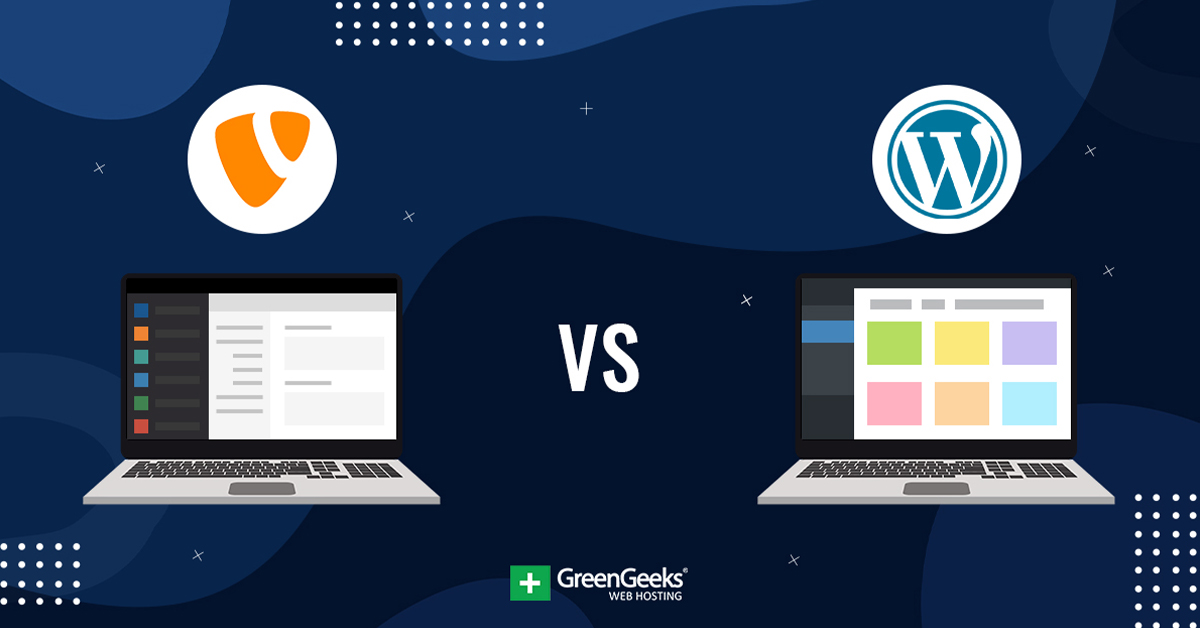
[ad_1]
Trying to decide which platform to build your website with isn’t easy, and two of the more popular options include TYPO3 and WordPress. Each has its strengths and weaknesses, which raises the question, which platform is better?
While both are free open-source CMS platforms, they differ greatly when it comes to their target audience. As a result, comparing them can be slightly difficult, but that’s what we are here for.
Today, I will be comparing each platform across several categories to see what’s better.
TYPO3 vs WordPress: Overview
Before we look at specific categories, let’s take a moment to figure out what each platform is at its core with a quick overview. Doing so will give us a better understanding of what each platform was built for.
What Is TYPO3?
TYPO3 is an open-source enterprise content management system built for experienced web developers. As a result, it has a slightly more involved installation process than most modern CMS platforms, but it’s still manageable.
While the learning curve is a bit higher, it’s still a popular choice among enterprise-level businesses.
Since it is built with enterprise businesses in mind, you will find a slew of useful multisite tools and some of the highest security standards in the industry. It is also packed with a variety of SEO tools built directly into the system.
While there are some tools you can purchase for extra features, the majority of what you need is already added to the platform, which is amazing for something that is free to use.
However, you will need to perform routine maintenance to get the best results.
What Is WordPress?
WordPress is an open-source CMS that was originally made for blogging. And it still has strong roots in blogging today, but it has evolved over time and can make any kind of website while supporting businesses at any level.
Due to this versatility, it has become the most popular platform to build websites.
Surprisingly, such a flexible platform is very easy to use. That’s because you can make an amazing website without ever writing a line of code. Instead, new features and designs are added by installing the right plugins and themes for the job.
As a result, it has become the most beginner-friendly option in the market. This means you have a huge community to work within, which makes finding developers that know the platform easy, and you can find tons of resources online.
Note: There are actually two WordPress platforms, WordPress.com and WordPress.org. This comparison will focus exclusively on the self-hosted version of WordPress, WordPress.org.
So What’s the Difference?
TYPO3 was made for enterprise-level businesses, while WordPress started off as a simple blogging platform before evolving into the most flexible CMS on the market. As a result, TYPO3 was built for more experienced users, while WordPress has beginners in mind.
While TYPO3 has everything you will need from the get-go, WordPress will require you to install the tools you want to use as plugins. Thus, only the tools you want or need will be present.
TYPO3 vs WordPress: Ease of USe
Generally, the two biggest deciding factors when picking a platform to build on are the price and how easy it is to use. In this case, they’re both free, thus, the accessibility of the platform is most likely the deciding factor for most.
Let’s take a look at which platform is more accessible.
TYPO3 Accessibility
Unfortunately, TYPO3 is not beginner-friendly. It is an enterprise-level platform, thus the creators assumed companies would be hiring web developers that have the necessary knowledge.
This also ends up meaning companies need to spend more on web developers in general, thus project costs go up.
However, for those with previous knowledge, the platform isn’t hard to pick up.
One thing that does make it a bit more complex is how many features you get out of the box. Normally, more features are a good thing, but it can be very overwhelming when looking at the platform for the first time, that is if you can actually install it.
Many users find the setup hard. While there is a handy setup wizard that helps configure the install, actually getting to that point seems to be the problem. You honestly need to prepare the installation files first.
Needless to say, a beginner will struggle.
WordPress Accessibility: Winner
WordPress was built for beginners, thus it has created a great reputation over the years. Users do not need any previous experience or coding knowledge. Instead, almost everything is done by picking the correct setting.
As a result, it’s become the most popular platform because anyone can make a website with it.
The content you create will be in their block-based editor, Gutenberg. It’s very intuitive to use. For example, if you want to add an image, just add an image block. Want to create a list? Add a list block. It’s really that simple.
The same can be applied to site features and tools.
If you need to create a backup, just install a backup plugin. Need a caching solution? No problem, install a caching plugin. Everything was made with beginners in mind, thus everything is intuitive and easy.
It’s also worth noting that if you aren’t happy with the default design tools WordPress offers, you can install new ones via plugins. For instance, you can install Elementor to build pages instead of using Gutenberg. More choices means more accessibility.
Results
There’s really no competition here. WordPress was created with all users in mind, while TYPO3 was built for experienced web developers. WordPress offers a one-click installation, where TYPO3 is more involved.
Truthfully, it’s hard for any platform to be more accessible than WordPress, but in this case, the gap in accessibility is huge.
TYPO3 vs WordPress: Security
The internet is not a very safe place. Everyone is constantly trying to cheat a system and steal someone else’s information. And being the website that gives up personal information is a death sentence. As such, making sure your website is protected is more important than ever.
Which platform is safer to use in 2022?
TYPO3 Security: Winner
As a platform made for enterprises, TYPO3 takes security very seriously and comes equipped with a variety of tools that can keep you safe. And since it is not a commonly used platform, it is less likely hackers are familiar with it.
One of the more useful features you can take advantage of is Multi-Factor Authentication (MFA). This allows you to set up multiple factors to the login besides a password.
The most popular example is 2FA where you need to get a password from another source, such as a confirmation text to a phone.
Of course, you can set up more than just one option. On the backend, you can actually customize the location of the /var directory to make it hard to find since it won’t be in a default position.
These are just a few of the things you can do.
WordPress Security
WordPress actually doesn’t have a good reputation when it comes to security, but that doesn’t mean it is unsafe. The truth is that WordPress makes up over one-third of all websites, thus it has a giant target on its back.
Hackers are more likely to target a WordPress website because they are the most common type.
However, there’s nothing wrong with WordPress’s security. It is constantly updated to patch out exploits and there are a variety of security plugins you can use to strengthen the security of your website.
The most common way a WordPress website is compromised is generally due to a third-party plugin. WordPress does not maintain every plugin in its repository, which creates a situation where a hacker can exploit a vulnerability and get in.
A simple way to combat this, though, is to install a security plugin like Wordfence. Even the free version of this tool can offer an incredible amount of protection from things like Brute Force attacks or unregistered file changes.
Results
While WordPress is a perfectly safe platform, its popularity makes it a bigger target than any other. TYPO3 on the other hand only handles enterprise-level businesses, thus, they take security very seriously.
And ultimately, they just do a better job with built-in features. While you can add similar features in WordPress, the plugins themselves tend to be the issue.
TYPO3 vs WordPress: SEO
The one thing that can make or break a website is search engine optimization (SEO). Thus, most platforms try to make their platform as search engine friendly as possible.
However, platforms are not equal when it comes to SEO.
Let’s take a look at which platform offers more optimization tools.
TYPO3 SEO
TYPO3 has an incredibly strong lineup of SEO tools that you can take advantage of, which is expected of all enterprise-level software. However, they can be a bit overwhelming to utilize, at least at first.
That said, once you get the hang of it, it’s easy to see why large businesses flock to TYPO3.
TYPO3 can be tuned for performance on particular devices. This can give you a huge boost in rankings because speed and usability are big factors that search engines like Google look at. And TYPO3 excels at them.
TYPO3 does support add-ons like Yoast that you can utilize to make the experience more manageable. It’s also worth noting that add-ons for TYPO3 tend to be at a higher cost than on other platforms, but again, it’s enterprise-level software.
WordPress SEO: Winner
The WordPress platform is used to create millions of websites, and that wouldn’t be the case if those websites didn’t rank highly. WordPress offers users full control over every aspect of their SEO while managing to make it easy.
That said, you really do need a basic understanding of SEO to get the most out of the platform.
When it comes to SEO tools, there is no bigger name than Yoast SEO. This plugin provides users with tips as they are creating content in real-time, such as keyword usage, internal & external link tracking, a google preview, and much more.
It even goes as far as to provide readability tips to ensure readers have an easier time consuming the content.
However, this is just one tool as there are actually hundreds of SEO plugins that do amazing work. As such, WordPress websites tend to rank highly on Google compared to other systems.
Results
This is a really tough comparison because both of these platforms excel at SEO and even support Yoast. However, I think WordPress has the advantage because Yoast is a free add-on for WordPress and is much easier to use.
That said, you will be able to rank high regardless of what platform you choose to use.
TYPO3 vs WordPress: Final Results
Simply put, WordPress is a better option for more websites when compared to TYPO3. It is easier to develop content for, provides multiple design tools to take advantage of, and will ensure your content ranks highly.
While I didn’t talk about the price since both platforms are free, the cost of development is much lower in a WordPress setting. This is because it’s much easier to develop content in WordPress and the fact that there are a lot more web developers familiar with the platform.
It’s also worth noting that there are just more resources available in the WordPress space. It has the largest community of any CMS platform, thus there is no shortage of helpful tutorials and tips to help beginners get started.
For these reasons and more, WordPress is the better choice.
Let me know what your favorite platform is in the comments below.
[ad_2]
Source link






